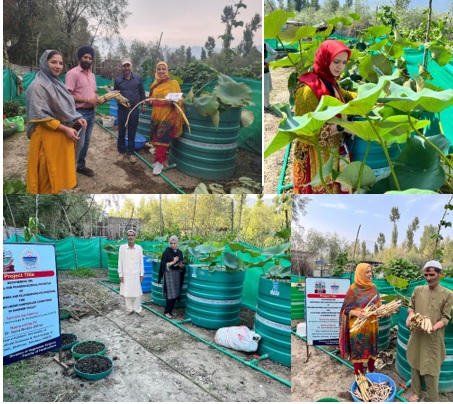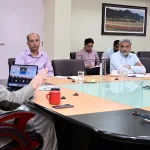Srinagar, Oct 11: Lotus stem, locally known as “Nadru” in Kashmir and “Kamal Kakdi” in India, is one of the novelties of Kashmir valley. Botanically lotus is a herbaceous perennial aquatic plant which belongs to the family Nelumbonaceae.In Jammu and Kashmir Nadru is a delicacy crop which is grown across water bodies / Lakes namely, Dal, Wular, Nigeen, Manasbal, Anchaar, and so on.
The stem although an expensive delicacy is much loved in Kashmir and is used in many Kashmiri cuisines. It packs a unique mix of nutrients and minerals, including potassium (12%), phosphorous, copper (29%), iron (6%), manganese (1%), thiamine (13%), pantothenic acid (7.5%), zinc (3.5%), vitamin B6 (13%), vitamin C (73%) and fibre (13%). It is naturally fat-free veggie with good sources of phytonutrients and have good vasodilator properties hence it help in blood circulation as well as in maintaining blood pressure. As lotus stem is a rich source of fibre, it aids in constipation. Since it’s a good source of vitamin C and forms an integral part of collagen, it helps in maintains strength and rigidity of blood cells, skin and body organs.
While Nadru cultivation has remained a self-accomplished practice with growers, there has been little to no scientific intervention so far in order to improve the production or to modulate the cultivation process towards efficiency. The problems faced under existing Nadru cultivation include difficult access, no control on input factors, no check on quality control, diseases & pests and threat of natural calamities (water pollution, floods, hailstorm and so on).
Limited area of cultivation, engagement of limited farmers, no business model established and limited assurance on production and supply are some other issues the crop faces at present. Development of package and practice for cultivation of Nadru with latest scientific interventions to harvest better quality and higher yield in this crop is therefore the need of the hour. This will lead to plummet the quantum of difficulties faced by the growers in cultivating Nadru under difficult to access natural habitat and help in it’s promotion.
Existing intricate mechanism of Nadru cultivation under natural habitat is uncontrolled due to least eminence for farmers who are associated with its cultivation. Cultivation of Lotus Stem (Nadru) under controlled microenvironment away from the natural habitat at SKUAST-K has decrypted the entrancing mechanism for cultivating it under manageable conditions.Present technology developed by Dr Syed Berjes Zehra, who serves as Assistant Professor in the Division of Vegetable Sciences, Faculty of Horticulture, SKUAST-K, Srinagar (J&K) is the first successful attempt in growing Nadru under controlled microenvironment for better production and improved supply. The initiative was taken under the JKDST funded project “Deciphering the nutritional and pharmaceutical potential of Nelumbonucifera (Nadru) and elucidating its potential for cultivation under controlled conditions in Kashmir valley”
This technology elucidates the mechanism for cultivation of Lotus Stem (Nadru) by optimizing the conditions including container design and input management. This technology brings Nadru from natural habitat “let it grow” conditions to controlled and manageable“let us grow” conditions.The technology will overcome the limitation by providing desirable microenvironment (light intensity, temperature, tank structure etc.), assuring timely input supply, disease and pest management, quality checks of the product through use of inputs like growth regulators, specific fertilizers. This will also help in expanding the period of availability, improve the production by involving a greater number of farmers and entrepreneurs. Opportunities will also arise for development of business models for livelihood and genuine returns for those associates with crop. This is the maiden technological intervention for taking Nadru cultivation from “Lakes to Tanks”. Under controlled microenvironment the benefit: cost ratio was enhanced manifolds (>3.0) deciphering the potential of this technology for enhancing economic returns and doubling farmer’s income.








